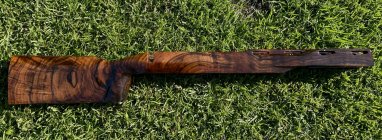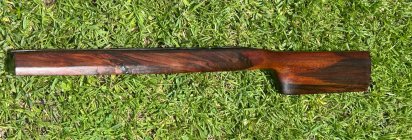You are using an out of date browser. It may not display this or other websites correctly.
You should upgrade or use an alternative browser.
You should upgrade or use an alternative browser.
Traditional Oil Stock Finishing
- Thread starter SGK
- Start date
When I was happy with the finish - or at least decided it was enough! - I removed the receiver/action and other metalwork from the fore-end and gave it a thorough clean with acetone to remove any dirt and slacum.
I then tried my hand at accentuating the (albeit very basic) engraving using the same method as described in the Purdey video linked to above. It's a subtle change but worth it I think. For this I used some drops of the Cobalt drier (mentioned above) mixed into a little black etching ink.
View attachment 1492707
You'll never come close to using the ink in the product above so it's likely much more sensible to use a little artist's oil ink (like Winsor & Newton) which come in much smaller tubes. The process is described well in the video so take a look there. You're dealing with black ink so wear gloves, have a mess-proof work surface and plenty of clean rags available. Also, have some acetone handy in case you need it for cleanup. I'd advise doing it piecemeal as opposed to attempting to do all the engraving in one shot even though it will cost you a bit of waste ink etc. Essentially you mix the ink and drier, smear it into the engraving (with a cotton bud) wait a couple of minutes and then clean off the surface, leaving just a small amount in the engraving to dry. Use multiple passes if necessary.
Here's a quick before and after shot. Hopefully you can see the subtle difference (as well as the bits I should do again).
View attachment 1492708
View attachment 1492709
Most comprehensive how-to I've ever seen. and explained in great detail. A bit over-the-top for me. but I can extract details that I personally find important.At this point I take a very clean rag and wipe down the checkering to make sure there’s no slacum/linseed oil sitting on the surface. Now we get out the rottenstone. Sprinkle it on the stock (avoiding the checkering) and gently work it over the surface with the palm and heel of the hand on larger areas and fingertips in finer places (across the grain). The rottenstone will find any excess slacum left behind. Once the stock is covered in rottenstone, wipe the surface clean with a clean rag. Brush out the checkering as much as possible. Very gently buff the stock and give it a close inspection to make sure no slacum or rottenstone residue is sitting on the surface. Set the stock aside to let it dry – at least 5-6 hours or better yet overnight.
In essence, you repeat this sequence until all the grain is filled in completely. Apply slacum. Wait for it to go tacky. Wipe it all off. Add rottenstone. Wipe off the excess. Let it all rest to cure. Repeat.
View attachment 1492479
View attachment 1492480
As more and more of the grain is filled in and ultra-thin layer upon layer of slacum builds on the surface, the stock will begin to shine. Really focus on whether you are filling in the grain in the less obvious areas of the stock such as the top, underside and around the metalwork and checkering.
View attachment 1492486
View attachment 1492487
View attachment 1492488
Cutting back the surface early on helps difficult grain areas ‘catch up’. My first few cuttings back were more aggressive than shown in the Purdey video for this reason. If you have difficult grain and haven’t used a filler it likely makes sense to cut things back relatively hard a few times earlier in the process. I used 2000 grit wet ‘n dry for the early cutbacks (of which I did two).
In the Purdey video, the finisher mentioned he cuts the surface back lightly after every 10 applications with fine grit wet ‘n dry paper. I was skeptical when I heard him talk about the wave that can develop as the slacum follows the nature of the wood. He was, however, dead right. 2000 grit is too coarse for these fine ‘flattening’ of the finish (as opposed to the cutting back to allow the grain filling). 3000 grit is a better choice. You’re not trying to cut back the finish as in my early ones but, rather, just lightly skim the major high points. Using too heavy a grit means more applications before the dullness of that cutting back disappears again, likely counteracting the purpose of these in the first place.
A lot of perseverance is required through this process. Cutting the surface back early on is like taking a few steps backwards in order to go forward. Difficult areas not addressed early (or in raising the grain and sanding) will still be there many, many applications later. As you progress, you’ll have to be more focused and gentler in the application of rottenstone.
Eventually, the grain will be completely filled in and there will be nowhere for the rottenstone to go and so we switch to using slacum alone. From here you need to be very careful. As there’s no longer any burnishing with rottenstone any smears of slacum left behind will become embedded under the next fine layer. Apply the slacum as before, wait until it’s tacky and then wipe off with a little BLO. Then burnish the stock with the heel of the palm. Wipe your palm on a clean rag frequently as it lifts any residual slacum. Rub firmly and let the friction generate some heat. Carefully inspect the stock to ensure you haven’t missed any areas or left smears behind. Set the stock aside to dry as before. Keep going until you’re completely satisfied with the finish. If you’ve missed some grain you’ll have to choose between cutting the surface back again or, perhaps, making a compromise as to the quality of the end result. As the saying goes, “it’s done when it’s done.” The highly experienced folk at Purdey do 40-50 applications. Novices (like me) can expect to do more.
Now I need to find someone who can take my beautifully figured blank and shape for my altered early 1885 Winchester. Thanks for the presentation and guide~!
Similar threads
Upgrades & Donations
This Forum's expenses are primarily paid by member contributions. You can upgrade your Forum membership in seconds. Gold and Silver members get unlimited FREE classifieds for one year. Gold members can upload custom avatars.

Click Upgrade Membership Button ABOVE to get Gold or Silver Status.
You can also donate any amount, large or small, with the button below. Include your Forum Name in the PayPal Notes field.
To DONATE by CHECK, or make a recurring donation, CLICK HERE to learn how.

Click Upgrade Membership Button ABOVE to get Gold or Silver Status.
You can also donate any amount, large or small, with the button below. Include your Forum Name in the PayPal Notes field.
To DONATE by CHECK, or make a recurring donation, CLICK HERE to learn how.













